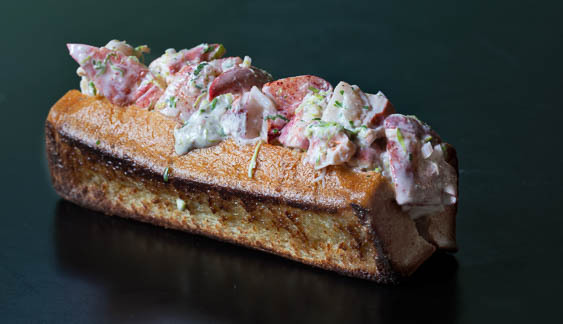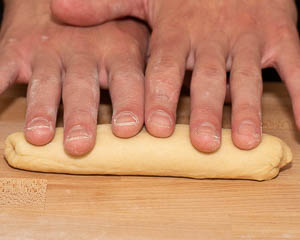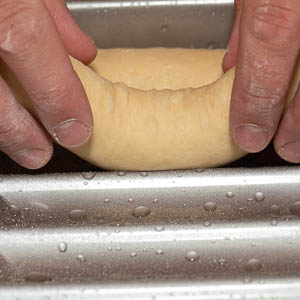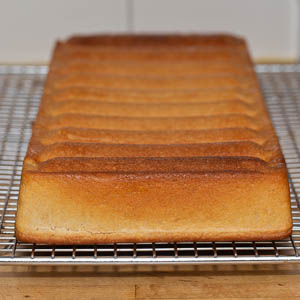New England–Style Hot Dog Buns

introduction
Conceptualized by the Howard Johnson’s hotel chain and executed in Maine by the J.J. Nissen baking company in the late 1940s, the pillowy, top-split bun is New England born and bred. Curiously, it was created not for a hot dog at all, but to satisfy demand for a tidier fried clam roll—one that stood tall and ate clean. The hot dog snuggled right in.
In this recipe, we reproduce the classic shape for New England–style hot dog buns but take executive privilege with the dough. The original formula was, after all, fabricated with bleached flour, dusty dried milk, and probably sprayed for color. Obviously, that wouldn’t do. We reached far outside New England and devised a version of Japanese milk bread structured from Anson Mills French Mediterranean White Bread Flour. Soft, fluffy, tender, and slightly sweet, the buns caramelize beautifully and contain only seven ingredients—as opposed to supermarket variants with over two dozen. We think of them as confirmed New Englanders with worldly inclinations.
Baking Notes
In order to achieve the quintessential flat-bottomed New England hot dog bun aesthetic, we chose a pan with prefab slots for each bun. Shaped and portioned individually, the buns proof and bake as a single piece, then are cut or scissored apart post-bake. We like this one made by USA Pans.
To get perfectly square tops, however, a bit of Yankee ingenuity came in handy: we put an improvised lid over the entire pan toward the end of proofing. Comprising a greased baking sheet weighed down with a cast-iron skillet, the sheet restricts the dough’s rise so the top bakes levelly, and the heft of the skillet prevents dough from spilling out the sides. The rig is removed after the first few minutes of baking. Make sure the baking sheet you use is perfectly level and un-warped.
Hesitant to go with our set-up? Skip the lid altogether, and allow the buns to proof until they just crest the top of the pan. Their shape won’t be classic New England style, but you can still top-split the buns and stuff them with whatever you like.
equipment mise en place
For this recipe, you will need a plastic bowl scraper; a digital kitchen scale; a parchment paper–lined baking sheet (if making hamburger buns with the extra dough); a New England–style hot dog pan; a metal bench knife; a rimmed baking sheet and a perfectly flat baking sheet; an 8- to 10-inch cast-iron skillet; and a wire rack.
-
-
1recipe Japanese Milk Bread, prepared through step 4
-
-
Lightly flour your work surface. Remove the plastic wrap from the bowl and dust the surface of the dough with flour. Run a plastic bowl scraper around the edges of the dough to release it from the bowl, then invert the bowl, allowing the dough to drop onto the floured surface. The dough will be very puffy, a sign of healthy fermentation. Sprinkle the dough with flour (fig. 1.1) and pat with your hands to de-gas thoroughly. Stretch the dough into a rough 10-inch square (fig. 1.2).
-
Cut a strip about 2 inches wide from the dough (fig. 2.1), then cut a square off that strip. Weigh the square—you’re aiming for a 70-gram piece. Trim off a bit if it’s too large, or add a sliver if it’s too small. Set the piece on a lightly floured area of your work surface. Cut another nine 70-gram portions of dough, for a total of ten. You will have about 200 grams of leftover dough; discard it or divide it in half to make a couple of hamburger buns.
-
Place one piece of dough on an unfloured area of your work surface and fold it in half on the diagonal. Cup your hand around the dough and move your hand in a small circular motion, dragging the dough along and allowing its bottom to grip the work surface. Continue to “round” the dough until it forms a compact ball with a smooth, taut surface and a sealed bottom (fig 3.1). Set the round on a lightly floured area of your work surface, then repeat with the remaining 70-gram portions of dough. Cover the rounds with a clean kitchen towel and let rest for 15 minutes. If you are making hamburger buns with the extra dough, shape those portions in the same way, then place on a parchment paper–lined baking sheet and cover lightly with a piece of plastic wrap sprayed with nonstick cooking spray.
-
Generously spray a New England–style hot dog bun pan with nonstick cooking spray. Lightly dust the dough rounds with flour. Using a metal bench knife, scrape up a dough round and flip it onto the work surface in front of you. Degas the dough with your hand and press it into a rough 4 by 2-inch oval parallel with the counter’s edge. Fold the far edge of the dough to the center and press to seal. Rotate the dough 180 degrees, then fold and press the other edge (fig. 4.1). Now fold the dough in half and press the seam to seal. Gently roll the dough against the work surface to even out its thickness and stretch it to the width of the pan (fig 4.2). Place the dough seam side down in the one of the slots in the prepared pan (fig. 4.3). Repeat with the remaining dough rounds. Spray a piece of plastic wrap with nonstick cooking spray and lay it over the pan, then set the pan on a rimmed baking sheet. Let the dough rise until it is about ¼ inch shy of the rim (fig. 4.4), 45 minutes to 1 hour. Meanwhile, adjust an oven rack to the lower-middle position and heat the oven to 400 degrees.
-
When the dough is properly risen, spray the bottom of a clean and very flat baking sheet with nonstick cooking spray, then set the sheet oiled-side down directly on top of the hot dog bun pan. Set an 8- to 10-inch cast-iron skillet on top of the sheet pan, then let the dough rise for 10 minutes longer.
-
Carefully slide the whole unit, including the baking sheet on the bottom, into the oven and immediately reduce the oven temperature to 350 degrees. Bake for 10 minutes. Carefully remove the baking sheet “lid” with the skillet and continue to bake until the buns are golden brown, 5 to 10 minutes longer.
-
Remove the pan from the oven and immediately invert the buns onto a wire rack (fig. 7.1). Let cool for at least 30 minutes before slicing at the seams into individual buns, splitting the tops, and stuffing with your filling of choice. If you are baking hamburger buns, immediately after removing the hot dog buns from the oven, return the oven temperature to 400 degrees. Slide the sheet pan with the buns into the oven, immediately reduce the temperature to 350 degrees and bake until golden brown, 10 to 12 minutes. Transfer the buns directly to the rack and let cool to room temperature.
-
-
1.1

-
1.2

-
-
-
2.1

-
-
-
3.1

-
-
-
4.1

-
4.2

-
4.3

-
4.4

-
-
-
7.1

-
Recipe by Henry Jones